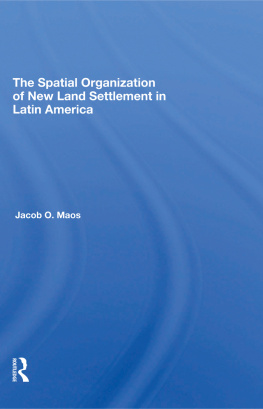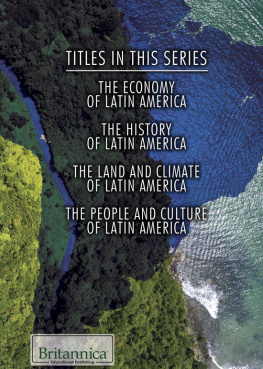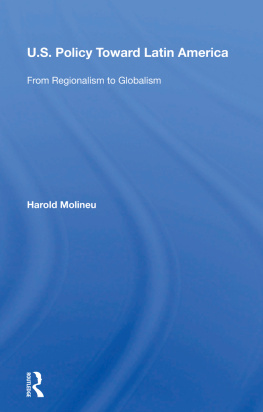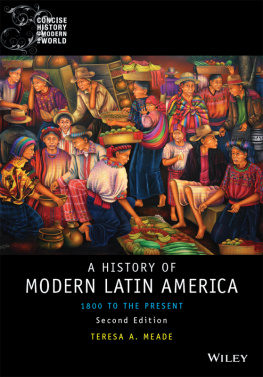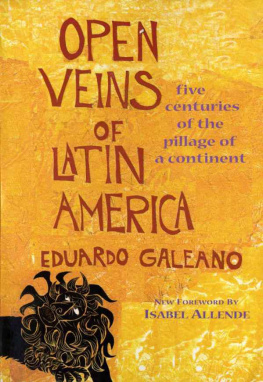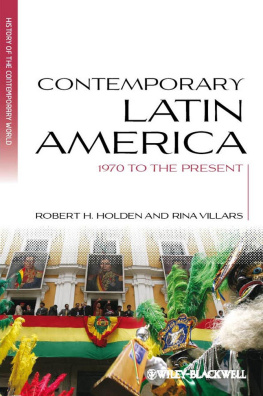The Spatial Organization of New Land Settlement in Latin America
Dellplain Latin American Studies
The Spatial Organization of New Land Settlement in Latin America
Jacob O. Maos
Land settlement in Latin America has become a subject of growing concern as governments renew efforts to develop agrarian potential and to relieve the pressure on overpopulated rural and urban areas. In this book, land settlement is viewed as the development of resources, both human and natural. The spatial organization of land settlement is examined in light of social and spatial patterns that may complement economic activities, lead to viable communities, and facilitate the provision of social and cultural amenities. The farm family is seen as the basic socioeconomic unit, and the family farmstead as the basic spatial nucleus.
Dr. Maos is associate professor in the Department of Geography, University of Haifa. He has served as a consultant to various United Nations agencies and is on the board of directors of the International Rural Housing Association.
Dellplain Latin American Studies
PUBLISHED IN COOPERATION WITH THE DEPARTMENT OF GEOGRAPHY SYRACUSE UNIVERSITY
EDITOR
David J. Robinson
Syracuse University
EDITORIAL ADVISORY COMMITTEE
David A. Brading
University of Cambridge
Daniel Raposo Cordeiro
Syracuse University
William M. Denevan
University of Wisconsin
John H. Galloway
University of Toronto
John Lynch
University of London
William Mangin
Syracuse University
EDITORIAL ASSISTANT
Jane E. McGraw
The Spatial Organization of New Land Settlement in Latin America
Dellplain Latin American Studies, No. 15
Jacob O. Maos
First published 1984 by Westview Press
Published 2019 by Routledge
52 Vanderbilt Avenue, New York, NY 10017
2 Park Square, Milton Park, Abingdon, Oxon OX14 4RN
Routledge is an imprint of the Taylor & Francis Group, an informa business
Copyright 1984 by the Department of Geography, Syracuse University
All rights reserved. No part of this book may be reprinted or reproduced or utilised in any form or by any electronic, mechanical, or other means, now known or hereafter invented, including photocopying and recording, or in any information storage or retrieval system, without permission in writing from the publishers.
Notice:
Product or corporate names may be trademarks or registered trademarks, and are used only for identification and explanation without intent to infringe.
Library of Congress Catalog Card Number 83-51156
ISBN 13: 978-0-367-29623-0(hbk)
The problems surrounding rural development have been amply described in professional literature; however, most of these studies have remained on a descriptive level. While several normative models, which purport predicting the outcome of alternative courses of action, have been developed in economic theory, many physical planning aspects, especially in rural areas, still have not been treated. The arbitrary separation between the spatial organization of settlements and their subsequent economic behavior has diverted the attention of planners from the potential inherent in spatial and social patterns of rural settlements. Even in new land settlement, the spatial rationale sometimes remains unquestioned while almost every other aspect is critically examined.
Some examples aptly demonstrate this point. In a treatise by an interdisciplinary group of experts from the M.I.T. Center for International Studies, the main ingredients for successful agricultural development were identified. A detailed list was formulated which included physical, economic, organizational, cultural and motivational, and knowledge factors. Surprisingly, the interrelationships among these factors and their arrangement in space and time were left unmentioned. The fact that new land settlement accounts for only a small part of the total agricultural production could explain the absence of spatial aspects from those factors considered to affect agricultural development; however, the opening of new lands occupies an increasingly prominent place in the policies and allocation of resources in many developing countries.
Current planning theories regard the marketplace as the crucial element in lending viability to rural settlements. The notion of market, however, is understood primarily in terms of the local peasant market. Mosher, in line with this concept, proposes the construction of a grid of farm-to-market feeder roads which, in combination with other inputs (i.e., fertilizers, credits, agricultural extension services, etc.), is expected to modernize
Johnson also regards the market system as a primary motivating force, but within a broader context of centralized locations which could serve as bases for development of the region's human resources. He admittedly concentrates on economic feasibility, but the physical planning related to these inputs is barely mentioned. As an inevitable conclusion of short-term economic objectives, Nelson advocates spontaneous settlementa solution which is contradicted by the principles and criteria expounded in this thesis.
The student of rural spatial organization will be hard pressed to find updated normative material on land settlement. Among the few studies and writings on the subject are the publications by the Settlement Study Center in Rehovot, Israel, which are applicable to some situations in developing countries, and others that direct themselves to specific areas, such as the comparative study of land settlement in Ceylon.
A combination of descriptive matter and conceptual analysis, which is indispensable in formulating planning strategies, is offered by Dorner, Dozier, L. Smith, Thiesenhusen, and Warriner.A good deal of information can be found in nonconventional publications most often available in the countries themselves. Most of this material, however, is mimeographed and tends to become extinct after several years. Some international cooperative programs operating in the area of agricultural development and land settlement have sparked the elaboration of a conceptual and technical framework for land settlement which is widely disseminated in Latin America and several Caribbean countries. Regional and international entities, such as the Organization of American States and United Nations' specialized agencies, are also collaborating in the field of land settlement and have published on the progress of their activities.
This book is an attempt to clarify the significant spatial aspects of land settlement, with the hope of formulating planning criteria which are compatible with the generic characteristics of development areas in Latin America. The argument put forward is that the failure of planned settlement can often be traced to its spatial organizationa repeatedly overlooked factor. How important is the component of spatial organization in new land development? The adequate organization of rural settlement enables the provision of health and education, as well as production along modern lines which may improve the economic status of the involved population. A crucial condition, however, is the need to preserve flexibility since physical plans, once incorporated into the landscape, are difficult to modify. The reviewed case studies and models suggest that social and spatial patterns that complement economic activities are conducive to the formation of viable communities. Viability is, in the long run, the most important criterion of successful settlement.


